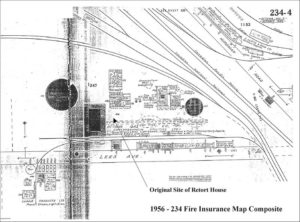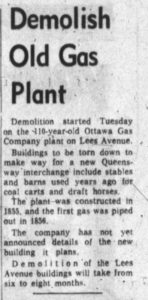Ken’s Bygone Sandy Hill
“Fireworks” displays from the Lees Avenue gas making plant
Ken Clavette
For many years my partner and I visited local long-term care homes in the region with our two golden retrievers. Often, we would run into residents that had a Sandy Hill connection, either growing up here or visiting grandparents. It was one of these people that told me about the entertainment kids got while sitting with their grandparents on a porch at the corner of Henderson and Somerset. The subject of their fun was the gas flares coming from the Lees Avenue gas making plant. Between 1920 and 1958 a large industrial gas site on Lees Avenue could be seen from the homes high on Sandy Hill and Confederation Heights. The flares that the children saw as fireworks were harbingers of future environmental destruction.
Up until 1854 oil burnt in Ottawa came from whales. Then an industrialization process allowed gas to be produced from coal. The first plant built by Ottawa Consumer Gas was at the corner of York Street and King Edward Avenue. After Ottawa East was annexed into Ottawa in 1907, the area just south of Sandy Hill along the Rideau River was designated commercial by the City.

The gas plant had a 10-storey high tank used to make what was called “Water Gas.” Coal was brought to the site daily on the many railway lines running into Sandy Hill. The gas was produced in a cyclical process with air and steam separating gas from the coal leaving behind coal tar. The gas was then piped through the city to be used mainly in heating. The tar was piped across Lees Avenue where it was used by Hamilton Tar Products (later Currie Products Ltd).
There was also a city-run garbage incineration plant that operated from 1912 until 1930 where the former Algonquin College campus, now uOttawa buildings and sports field, are located. With railways, the incinerator and the gas plant the view south from Sandy Hill to the river was anything but looking at the beauty of nature.
The times did not place environmental protection very high on the social-political agenda. From 1930 onward into the 1940s, after the garbage incineration ceased operating, there were two large landfill sites along the river where now stand two apartment buildings and the open space being held for the Alta Vista Expressway (sometime in our future).
 In 1958 Ottawa switched to “natural gas” and the plant was no longer needed. It was used as a storage yard by the gas company until 1966 when it was sold. The new owners demolished the buildings and covered over the many underground tanks on the site. There they remained until the building of the transitway in 1986 opened them up and the carcinogenic tar started to leak into the river. Today there is an underground collection system associated with the transitway that collects contaminated water.
In 1958 Ottawa switched to “natural gas” and the plant was no longer needed. It was used as a storage yard by the gas company until 1966 when it was sold. The new owners demolished the buildings and covered over the many underground tanks on the site. There they remained until the building of the transitway in 1986 opened them up and the carcinogenic tar started to leak into the river. Today there is an underground collection system associated with the transitway that collects contaminated water.
I always think that the builders of today should really study history or talk with the elders about what the land was used for in their youth. If they did the Folly play structure in Strathcona Park would not have been built in an old canal bed with the resulting flooding, the OTrain builders would have known why this community is called Sandy Hill, and someone could have told them about a gas plant south of Sandy Hill that once entertained local children and probably left behind a toxic industrial site.


LAC 5066177

LAC 5066176
